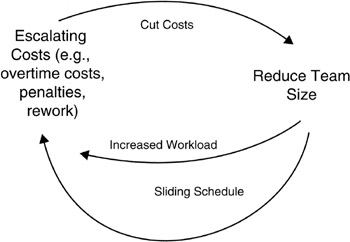Benefits
A systemic view of projects, however, provides many benefits to project managers.
Focus first and foremost on the big picture by ascertaining how all elements of a project interact. By understanding interactions, project managers can more easily determine the impact of their decisions and actions, negative and positive. Capra writes that a systems perspective really involves looking at objects as networks of relationships that are part of a much bigger system. Hence, relationships become more important than objects. [3] This unified perspective enables project managers to determine the most appropriate decision or action to further progress. For example, a project manager can determine the key elements and their relationships that need to change in order to achieve the best results.
Provide a more balanced perspective between efficiency and effectiveness. Project managers can see, for example, the impact of cost cutting of elements and their relationships, such as activities and resources, on overall effectiveness. Many project managers lack this visibility, falling into the trap due to their narrow perspectives.
Be decisive and act in a manner that optimizes the overall performance. For example, a project manager can identify opportunities for improvement and anticipate any possible negative impacts in advance. In other words, he or she can perform an impact analysis of their decisions.
Step back and see how their decisions and actions impact an entire project and other stakeholders. Project managers can handle organizational myopia more readily. They can also be more tolerant of who does not share the same perspectives. This ability to "elevate" perspectives offers another important benefit: consensus. Because people can see a project from other and larger perspectives and an appreciation of the impact of their actions on others, consensus is more achievable. Often, a lack of consensus occurs because of people's inability to understand the how and why behind other people's thinking and doing, resulting in needless negative conflict. A systemic view of a project enables easier consensus by recognizing diversity and encouraging understanding of issues and interests of all stakeholders in making decisions and taking action.
See not only the impact of their decisions, but also ascertain a sense of the long-range impacts through understanding relationships. That is what really makes systems thinking valuable . According to Peter Senge, systems thinking requires a holistic perspective that identifies interrelationships and patterns rather than what he calls "snapshots." [4] With this knowledge, project managers can develop more effective contingency plans, or set aside sufficient funds, e.g., management reserves , to deal with long- term consequences.
Figure 5.2 demonstrates the power of taking a systemic perspective to ascertain the impact of short-term fixes vis- -vis long-term fixes. A common scenario is, for example, project managers having to deal with exceeding budgets . To cut costs, they reduce team size even though the scope does not change. The result is an increased workload that causes the schedule to slide, adding costs to the project, e.g., penalty payments and overtime costs.

Figure 5.2: Fixes that Fail.
Focus on what to do and why, rather than how. Mechanics of a process or a procedure, for example, become the most important consideration and not necessarily the steps. Project managers then have considerable flexibility to respond to different situations. For example, a project manager can consider different alternatives to achieve a specific objective rather than improve processes that may not necessarily contribute towards improving overall performance. In the end, he or she knows more of what is important and less of what is irrelevant. As Edward de Bono says, the reason that it is easier to notice an effect than it is to understand the causes for its existence. [5]
Achieve synergy, the concept that system output is greater than the sum of its parts . In other words, there is an increased value of the parts of a system because they are members in a system.
Have a better means to adapt to the environment. Because they identify interrelationships and relationships, project managers can modify processes, procedures, tools, and techniques in a manner to focus on goals and objectives. This ability to bring about changes that have the most effective impact is called leveraging in systems thinking. Edward De Bono says that for complex systems, it is not really an issue of making results happen but influencing elements to get the desired effect. He calls this the "dynamic approach." [6]
[3] Fritjof Capra, The Web of Life , Flamingo, New York, 1997, p. 36.
[4] Peter M. Senge, The Fifth Discipline , Currency Doubleday, New York, 1990, p. 68.
[5] Edward De Bono, Practical Thinking , Penguin Books, London, 1971, p. 45.
[6] Edward De Bono, Practical Thinking , Penguin Books, London, 1971, p. 43.
EAN: 2147483647
Pages: 169